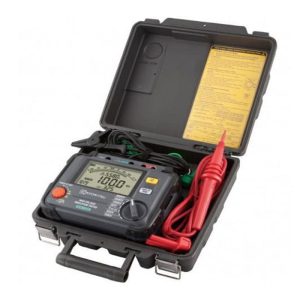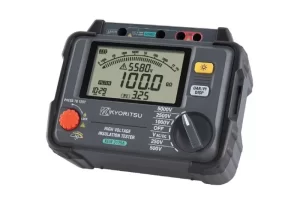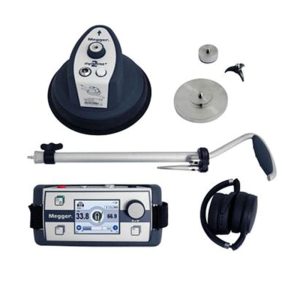If you work with cables, you are aware of how crucial it is to have a trustworthy cable tester.
Your electrical system’s performance and safety might be impacted by cable problems, such as breakage, shorts, or leaks, which a cable tester can help you find and fix. In order to prevent power outages, fires, or electrocution, cable defects must be identified and fixed right away.
However, how can you pick the ideal cable tester for your requirements? Cable testers come in a wide variety of styles and models, each with unique features and capabilities.
We’ve compared the Kyoritsu KEW 3125A digital high voltage insulation tester and the Megger digiPHONE+2 SHOCK WAVE RECEIVER in order to help you make an informed choice.
These two tools are made to make it simple and effective for you to find and identify cable issues. Which one is better for your needs and how do they differ?
Let’s examine their features and characteristics in more detail.
For the purpose of locating cable faults, the Megger digiPHONE+2 SHOCK WAVE RECEIVER combines electromagnetic and acoustic techniques.
When it encounters a cable failure, it can recognize the shock wave created by a thumper or a surge generator.
A device called a thumper, or a surge generator sends a high voltage pulse across the cable to spark at the site of the defect.
The shock wave created by the spark can be heard on the ground or on the cable sheath as it moves along the cable.
The sensor for the Megger digiPHONE+2 SHOCK WAVE RECEIVER can be placed on the floor or on the cable sheath to pick up magnetic and audible impulses.
In order to assist you in locating the fault, the device also contains a display that shows a fault arrow, a cable compass, and a distance indicator.
The Megger digiPHONE+2 SHOCK WAVE RECEIVER’s background noise reduction (BNR) technology, which blocks out interfering signals and creates an uninterrupted audio experience, is one of its key features.
This indicates that you can only hear the malfunctioning sound and not any other noises that can confuse or distract you.
When working in noisy locations or close to power sources that could produce annoying sounds, this feature is extremely helpful.
The Megger digiPHONE+2 SHOCK WAVE RECEIVER offers an additional benefit in that it features an automatic proximity mute (APM) feature that turns off the sound when the sensor handle is approached or lowered, reducing banging or cracking noises.
This indicates that you can move the sensor around without endangering your ears or interfering with your hearing. When working in small locations or close to those who could be annoyed by loud noises, this feature is extremely helpful.
For locating faults in low and medium voltage cables, the Megger digiPHONE+2 SHOCK WAVE RECEIVER also includes a few optional functions that make it more functional and user-friendly.
As an illustration, it offers optional Bluetooth headphones for wireless use.
This indicates that there aren’t any cables or cords that could get in the way or restrict your mobility while using the item.
When you are working in a big space or a remote place where power outlets might not be readily available, this feature is extremely helpful.
The Megger digiPHONE+2 SHOCK WAVE RECEIVER also has an additional optional feature: a step voltage location (NT Set) for sheath defect testing.
The voltage differential between two sites on the ground along the cable route can therefore be used to test the insulation of the cable sheath. When working with underground cables or cables that have damaged sheaths that could allow current to leak to the earth, this capability is extremely helpful.
The Megger digiPHONE+2 SHOCK WAVE RECEIVER offers an optional cable tracing (NTRX Set) for line locating as a third optional feature.
This means that by transmitting a low frequency signal through the cable and detecting it with a receiver, you may determine the location of the cable. When working with subterranean cables or wires whose courses are unknown and may cross other cables or pipes, this capability is extremely helpful.
Locating problems in low and medium voltage cables up to 65 km long is possible with the Megger digiPHONE+2 SHOCK WAVE RECEIVER.
It is simple to use because there are no manual settings necessary and all parameters are automatically adjusted. It comes with a durable protective case for transit and protection.
The insulation resistance of high voltage cables up to 5 kV is measured by the Kyoritsu KEW 3125A digital high voltage insulation tester.
The insulation resistance serves as a gauge for how well the insulation material stops current from the conductor from leaking out.
The possibility of current leakage, which can result in overheating, short circuits, or electric shocks, is increased by poor insulating resistance. Because there is a low chance of current leakage and the insulation resistance is high, the cable is in good shape and safe to use.
To assess the state of the insulation, the Kyoritsu KEW 3125A digital high voltage insulation tester can also run diagnostic tests including the polarization index (PI) and dielectric absorption ratio (DAR). In these tests, the rate at which the insulation material absorbs or releases electric charges in response to a high voltage is measured.
An insulation material with a high PI or DAR has good dielectric characteristics and can endure high voltages without degrading. If the insulation material has a low PI or DAR, it has poor dielectric characteristics and is readily damaged by high voltages.
The Kyoritsu KEW 3125A digital high voltage insulation tester includes an easy-to-read big display with bar graph indication.
Table of Contents
ToggleThe gadget also has a few functions that make it easy and secure to use:
It can quickly charge capacitive loads thanks to its short-circuit current of up to 1.5 mA. As a result, testing long connections or cables with high capacitance can be done quickly after the test voltage reaches the desired level.
It contains a filter function that lessens noise interference so that measurements can be taken steadily. This implies that the accuracy of the results won’t be impacted by testing cables in busy areas or close to power sources.
The user is warned of any potentially hazardous voltage by a live voltage warning on the test leads. By doing this, you can prevent unintentional contact with live wires or terminals that could result in electric shocks or harm the equipment.
It adheres to the IEC 61010-1 CAT IV 300V/CAT III 600V safety standard. This indicates that the gadget is built to withstand high voltage surges or transients that could happen on the power lines or wires.
It has a freshly created alligator clip that can be connected to different terminal kinds. This indicates that you can use various cables or pieces of equipment to connect the item without the use of adapters or converters.
It includes a sturdy protective case for travelling and protection.
For evaluating the insulation resistance of high voltage cables up to 1 T, use the Kyoritsu KEW 3125A digital high voltage insulation tester.
It doesn’t require any manual adjustments and has a large test voltage range of 250 V to 5000 V, making it easy to use.
As you can see, depending on your application and desire, each gadget has pros and cons of its own.
While the Kyoritsu KEW 3125A digital high voltage insulation tester is more accurate and dependable for evaluating high voltage cable insulation resistance, the Megger digiPHONE+2 SHOCK WAVE RECEIVER is more adaptable and user-friendly for locating faults in low and medium voltage cables. Both gadgets include sturdy casings that can be used for storage and traveling.
But how do these gadgets stack up against competing brands? How do they fare in actual-world situations? How do they assist you in time and money savings? We have gathered some customer testimonies from people who have used these tools for work in order to respond to these inquiries.
Some of their tales are as follows:
“I have been using the Megger digiPHONE+2 SHOCK WAVE RECEIVER for over a year now and I am very satisfied with it,” says John, an electrician from New York. It is quite simple to use, and it aids in my quick and precise identification of cable issues.
I enjoy how the sound is muted when I move the sensor and how it filters out surrounding noise. Additionally, it includes a great display that tells me the location of the problem and how far it is from me.
My work is more comfortable and convenient because I can operate wirelessly with the optional Bluetooth headphones.
The gadget has a sturdy case that shields it from harm and is quite durable. I would suggest this tool to anyone looking for a dependable cable fault locator.
London-based cable technician Mary says of the Kyoritsu KEW 3125A digital high voltage insulation tester:
“I have been using it for more than six months and am quite satisfied with it. It is quite easy to use and provides me with accurate insulating resistance measurements.
In order to assess the insulation’s condition, I also utilize it to conduct diagnostic tests like polarization index and dielectric absorption ratio.
It has a sizable display with illumination, bar graph, and easy reading text. Additionally, it contains functions like the short-circuit current, filter function, live voltage warning, safety standard, and a newly created alligator clip that make it safe and comfortable to use.
A protective case that shields it from harm is also included. I would suggest this tool to anyone who requires an accurate and dependable insulation tester.
“I have been using both the Megger digiPHONE+2 SHOCK WAVE RECEIVER and the Kyoritsu KEW 3125A digital high voltage insulation tester for over three months now, and I am very impressed with them,” says Sam, a cable engineer from Sydney.
Both of them are quite simple to use, and I can easily and quickly utilize them to identify and diagnose cable defects.
Both of them have features that set them apart from other cable testers, including background noise cancellation, automatic proximity muting, Bluetooth headphones that are optional, step voltage location that is optional, cable tracing that is optional, short-circuit current, filter function, live voltage warning, safety standard, and a newly designed alligator clip. Each of them also includes a protective cover to shield them from harm.
Both of these gadgets, in my opinion, are excellent, and I would suggest them to everyone who works with cords.
These are just a few examples of customer reviews from people who have used these tools for work. You can see that they are really happy with their work and quality. They also value how quickly and safely these tools can locate and diagnose cable failures, saving them time and money.
You can visit their separate websites or get in touch with their distributors for more information if you’re interested in purchasing these gadgets or finding out more about them. Additional details about cable fault location and diagnosis are available from a number of online sites.
Anyone who deals with cables needs to have the ability to locate and diagnose cable faults. You can make sure your cables are in good shape and safe to use by picking the best cable tester for your needs.
In this post, we’ve evaluated two of the most often used cable testers: the Kyoritsu KEW 3125A digital high voltage insulation tester and the Megger digiPHONE+2 SHOCK WAVE RECEIVER. These two tools are made to make it simple and effective for you to find and identify cable issues.
In order to prevent power outages, fires, or electrocution, cable defects must be identified and fixed right away.
The features and specifications of these devices have been covered, including their methods for cable fault location and diagnosis, their display and sensor functions, their noise reduction and mute functions, their optional features for wireless operation, sheath fault testing, and cable tracing, their short-circuit current and filter function, their live voltage warning and safety standard, their newly designed alligator clip and hard case, and their test voltage range and range.
The benefits and drawbacks of these gadgets have also been covered, depending on your needs and preferences.
While the Kyoritsu KEW 3125A digital high voltage insulation tester is more accurate and dependable for evaluating high voltage cable insulation resistance, the Megger digiPHONE+2 SHOCK WAVE RECEIVER is more adaptable and user-friendly for locating faults in low and medium voltage cables. Both gadgets include sturdy casings that can be used for storage and traveling.
Additionally, we have gathered some client testimonies from people who have utilized these tools for work.
They have shared their experiences and opinions about these devices, such as how they are easy to use and help them locate cable faults quickly and accurately, how they filter out background noise and mute the sound when moving the sensor, how they have optional Bluetooth headphones for wireless operation, how they have optional step voltage location and cable tracing features for sheath fault testing and line location, how they have short-circuit current and filter function for fast charging of capacitive loads and stable measurements, how they have live voltage warning and safety standard for avoiding electric shocks and surges, how they have newly-designed alligator clip for connecting to various types of terminals, how they have a large display with bar graph indication and backlight for easy reading, how they perform diagnostic tests such as polarization index and dielectric absorption ratio to evaluate the condition of the insulation, how they are durable and come with hard cases for protection and transportation. Additionally, they have remarked how happy they are with the caliber and performance.
They have also valued how these tools enable them to save time and money by swiftly identifying and diagnosing cable failures.
The Megger digiPHONE+2 SHOCK WAVE RECEIVER and the Kyoritsu KEW 3125A digital high voltage insulation tester have been compared as the two most common cable testers.
We have talked about their attributes and details, benefits and drawbacks, client endorsements, and information sources.
We trust that this post has given you a better understanding of the distinctions between these tools and how they might benefit your business. I appreciate you reading.




